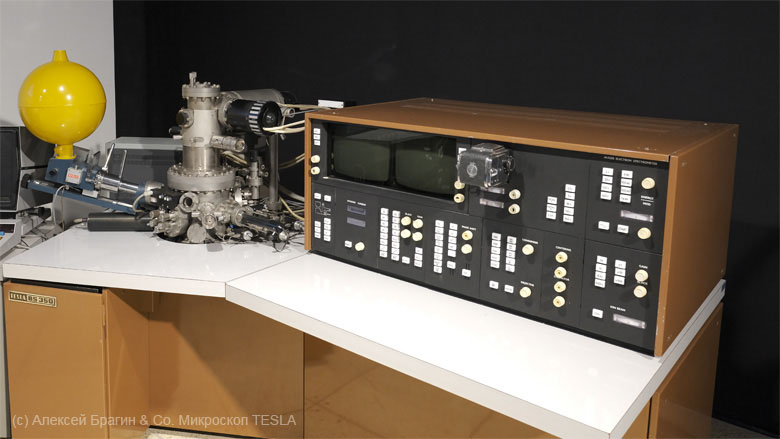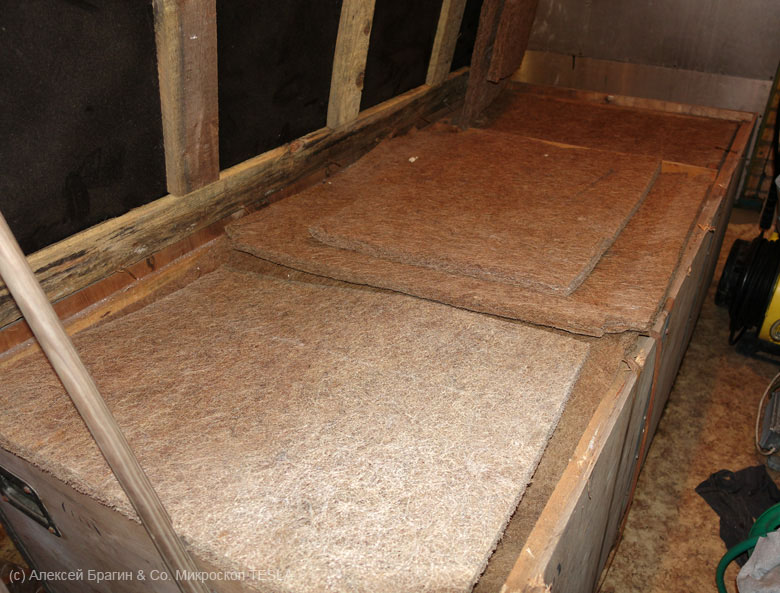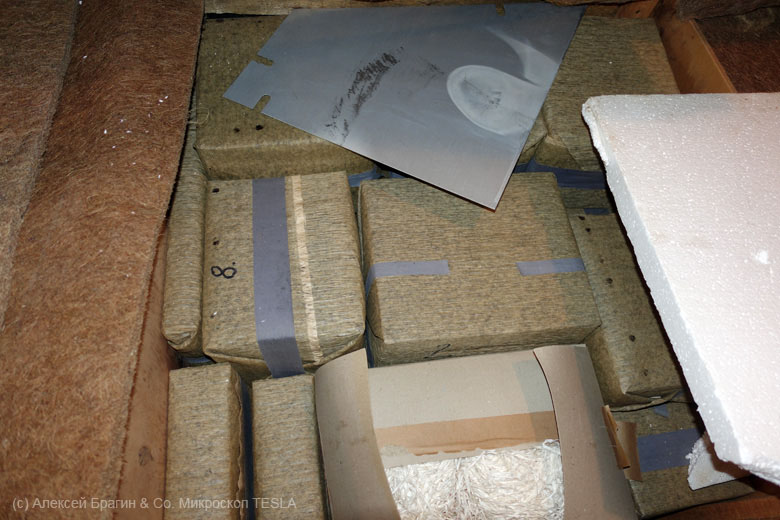Garage find: TESLA without run
Hello everyone, I get in touch again and see what happens! In the photo - a very rare (56 pieces were released for 1989) scanning electron microscope manufactured by TESLA company , exhibited in the Technical Museum of Brno . The ultrahigh vacuum column, the cathode with cold field emission made it possible to achieve a guaranteed resolution of 5 nm and an increase of 500000x.

I managed to get into my garage the exact same microscope that had lain unopened since 1990. Review and all the details of the unpacking process - under the cut.
Most likely, the “fault” of the fact that the microscope has survived until now was the difficult geopolitical situation of 1989-1993. The microscope was sent from Czechoslovakia to the USSR (probably by train, judging by the abundant traces of vibration), and almost on the way both countries ended their existence. In the USSR / Russia, it was somehow not up to the science, and in Czechoslovakia / the Czech Republic - not before the commissioning works, the national company TESLA was reformed in 1990.
After that, in some miraculous way, the microscope boxes stood in the open spaces of our Motherland until 2018, before getting to me.
I brought it, unloaded it in the garage (in another, not in the one in which JEOL and machine tools), immediately took a photo.
Control panel:

High vacuum column:

And three more wooden boxes. This is the largest of them with the lid open:

There are a lot of boxes signed in Czech or simply numbered in it:

If you compare it with a photo from the beginning of the article, you can see that the control panel is very similar, the column is also similar, but some parts are missing, there are no connecting wires at all.
For a short time, let's digress from unpacking to have an idea what kind of thing this is.
The site radiohistoria.sk found a scanned piece of paper with a detailed listing of the technical characteristics of the microscope. In short:
All difficulties with ultra-high vacuum are needed precisely because of the use of the autoemission cathode.
What are its advantages?
Communicating with representatives of the modern microscopic industry, I asked everyone this question, and the answer to it sounded like this: "it is much better, but much more expensive."
I tried to understand the topic a little deeper, and it turned out that everything is quite simple.
In some ways, the field cathode and thermal emission can be compared like a laser with an incandescent bulb.
In a scanning electron microscope, an image is formed by the effect of an electron beam on a sample point-by-point, by scanning. The thinner the spot of this beam, the higher the resolution can be achieved. And the brighter the spot, the greater the signal-to-noise ratio, and the faster you can get a high-quality image.
Therefore, the main task is to “reduce” the size of the electron beam to as thin as possible, but without losing its energy. This is done using an electromagnetic lens system (the very one or two condensers, an objective lens).
The size of the radiation source of a field cathode is about 100 nm (according to other data, in general, about 5 nm is the virtual size), the thermionic cathode is 30,000 nm. It is clear that in the case of a thermionic cathode we need to reduce it thousands of times, and the field one - to tens.
Another advantage of the field cathode is a high monochromatic radiation, i.e. smaller scatter of the energy of the emitted electron beam. This is important because electrons with different energies are deflected by the lenses in different ways (chromatic aberrations, by analogy with optical systems).
Great? Yes, but there are drawbacks. First, an ultrahigh vacuum is necessarily needed for autoemission, the deeper the better. Otherwise, the cathode will be unstable or will not work at all. Secondly, and most importantly, do not make such a cathode on your own. This is a tungsten crystal with a special orientation (310), in the shape of a needle.
What happened in this column in 30 years, is there any vacuum (hardly), and will we ever be able to launch it - the questions are open. But I really want to try!
In continuation of the story I propose to watch the video
I try to document all the actions with him, still quite a unique instance.

I managed to get into my garage the exact same microscope that had lain unopened since 1990. Review and all the details of the unpacking process - under the cut.
Most likely, the “fault” of the fact that the microscope has survived until now was the difficult geopolitical situation of 1989-1993. The microscope was sent from Czechoslovakia to the USSR (probably by train, judging by the abundant traces of vibration), and almost on the way both countries ended their existence. In the USSR / Russia, it was somehow not up to the science, and in Czechoslovakia / the Czech Republic - not before the commissioning works, the national company TESLA was reformed in 1990.
After that, in some miraculous way, the microscope boxes stood in the open spaces of our Motherland until 2018, before getting to me.
I brought it, unloaded it in the garage (in another, not in the one in which JEOL and machine tools), immediately took a photo.
Control panel:

High vacuum column:

And three more wooden boxes. This is the largest of them with the lid open:

There are a lot of boxes signed in Czech or simply numbered in it:

If you compare it with a photo from the beginning of the article, you can see that the control panel is very similar, the column is also similar, but some parts are missing, there are no connecting wires at all.
For a short time, let's digress from unpacking to have an idea what kind of thing this is.
Specifications
The site radiohistoria.sk found a scanned piece of paper with a detailed listing of the technical characteristics of the microscope. In short:
- The diameter of the scanning spot is 25 Å (2.5 nm). The magnification range is 100x - 500 000x.
- The weight of a column is 250 kg, the control panel is 200 kg.
- The microscope is equipped with two pumps of the “Orbitron” type (I’ll take a separate video about them and / or write an article) and one ion pump to achieve an ultrahigh vacuum in the cannon.
- For preliminary pumping, a cryosorption pump is used.
- Field emission cathode
All difficulties with ultra-high vacuum are needed precisely because of the use of the autoemission cathode.
What are its advantages?
Communicating with representatives of the modern microscopic industry, I asked everyone this question, and the answer to it sounded like this: "it is much better, but much more expensive."
I tried to understand the topic a little deeper, and it turned out that everything is quite simple.
Field emission
In some ways, the field cathode and thermal emission can be compared like a laser with an incandescent bulb.
In a scanning electron microscope, an image is formed by the effect of an electron beam on a sample point-by-point, by scanning. The thinner the spot of this beam, the higher the resolution can be achieved. And the brighter the spot, the greater the signal-to-noise ratio, and the faster you can get a high-quality image.
Therefore, the main task is to “reduce” the size of the electron beam to as thin as possible, but without losing its energy. This is done using an electromagnetic lens system (the very one or two condensers, an objective lens).
The size of the radiation source of a field cathode is about 100 nm (according to other data, in general, about 5 nm is the virtual size), the thermionic cathode is 30,000 nm. It is clear that in the case of a thermionic cathode we need to reduce it thousands of times, and the field one - to tens.
Another advantage of the field cathode is a high monochromatic radiation, i.e. smaller scatter of the energy of the emitted electron beam. This is important because electrons with different energies are deflected by the lenses in different ways (chromatic aberrations, by analogy with optical systems).
Great? Yes, but there are drawbacks. First, an ultrahigh vacuum is necessarily needed for autoemission, the deeper the better. Otherwise, the cathode will be unstable or will not work at all. Secondly, and most importantly, do not make such a cathode on your own. This is a tungsten crystal with a special orientation (310), in the shape of a needle.
What happened in this column in 30 years, is there any vacuum (hardly), and will we ever be able to launch it - the questions are open. But I really want to try!
Unpacking and review
In continuation of the story I propose to watch the video
I try to document all the actions with him, still quite a unique instance.
